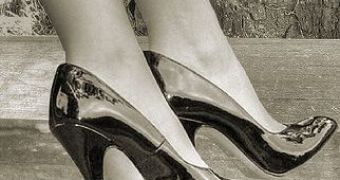Wearing high heels all the time brings the body to adapt in its own way by shortening the calf muscles, researchers found out recently. As some women wear high heels all-day long, what this is doing to their body was simple to observe. Apparently the body adapts but most women don't appreciate the side-effects.
This new research published today (Friday) in the Journal of Experimental Biology helps explain why women who wear stilettos feel discomfort when changing to regular flat shoes. High-heel wearing changes the calf muscle and tendons and walking on the tip of the toes becomes the body's new “natural” position.
In this study took part 11 43 year-old (average) women who have been wearing high-heels of at least 5 centimeters for five days a week for the last two years at least. A control group of nine women not wearing high heels regularly was also considered.
Magnetic resonance imaging was used to measure women's calf muscles, without finding any differences between the two groups. A second measurement implied ultrasound for determining the length of calf muscle fibers and this time a change due to high-heels was found. Women wearing them regularly had calf muscles 13 percent shorter than women in the control group.
When the ankles are raised because of the heels, the muscle finds itself in a contracted position. If maintained in this position for a long time, it actually shortens permanently, according to study researcher Marco Narici of Manchester Metropolitan University in the United Kingdom. Shorter calf muscle fibers mean that the muscle contracts differently, generating less force and altering walking's efficiency for these women. Still, scientists did not find any differences of muscle contraction between the two groups.
When researchers measured the Achilles tendon (connecting the muscle to the bone), they noticed that it was 20 percent stiffer and thicker in women wearing high heels. It is a natural adaptation of the body to compensate the muscle fibers shortness and allow the muscle to behave normally, said Narici.
A shorter calf muscle and a more thicker and rigid Achilles tendon is what gives soaring feet to women wanting to take a break from stilettos. In a way the feet adapted to the imposed position and they feel more comfortable in high-heel shoes, the study says. Nevertheless, Narici does not recommend women to abandon their classy shoes. He advises though some stretching exercises after a long day of wearing high heels.
This research on high-heel wearing effects was made by Marco Narici along with Robert Csapo of the University of Vienna, Austria, and Olivier Seynnes and Costis Maganaris of Manchester Metropolitan University.

 14 DAY TRIAL //
14 DAY TRIAL //